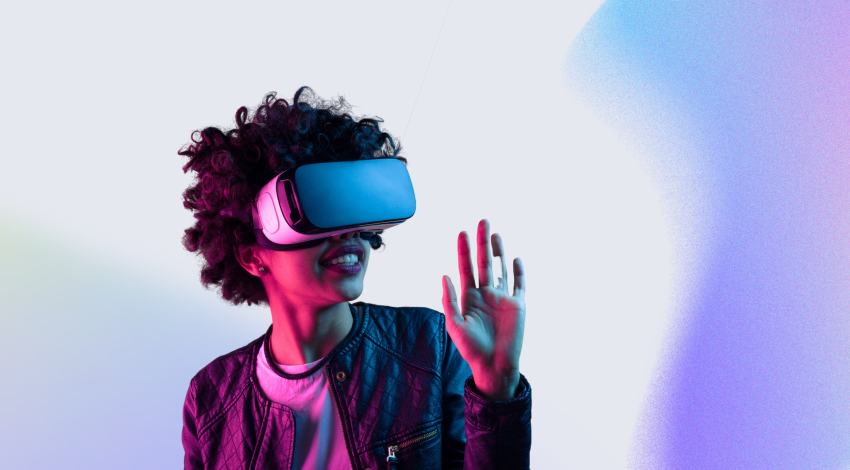

The past two years have seen the equivalent of a decade's worth of progress in EdTech. Therefore, this year 2022 will mark not a revolution but rather an evolution. As you may know, we were present at CES Las Vegas in early January, and we saw quite a few innovations. The EdTech trends for 2022 are emerging over the course of the months.
The Covid-19 pandemic has popularized blended learning, hybrid learning, and comodal courses. What do all these terms mean?
First, let's define the terms "synchronous" and "asynchronous" so that you can understand the context. "Asynchronous" learning involves online teaching modules that learners engage with at their own pace. Learners have access to various educational resources (audio files, videos, quizzes, interactive content, etc.) that they can access freely. On the other hand, "synchronous" learning corresponds to a traditional, live class. In other words, learners follow the course steps simultaneously. The instruction is delivered collectively, whether in-person or online.
Hybrid learning involves combining various modes of delivery in a pedagogical approach. For example, for the same course, you could have the first three sessions on-site, the fourth asynchronously (recorded class), and then another on-site session for the next one, and so on. Hybrid learning can also be used as a technical means to bring together learners from different countries, for instance.
Regarding comodal learning, it's a course available in all three modes, with two or three separate classes. In other words, one group is physically present, another group attends live online, and the last group accesses replayed classes asynchronously. When involving two modes, it can also be referred to as "bimodal."
Lastly, blended learning combines in-person instruction with digital learning without an instructor. Learners rely on materials such as texts, interactive quizzes, prerecorded videos, etc. They can then ask questions and interact in-person with the instructor.
While many instructors have found returning to in-person instruction a great relief, the infrastructure remains in place to make hybrid learning the norm. In-person instruction provides human interaction and natural communication, but certain existing EdTech solutions maintain the same level of interactivity online as in-person. Numerous tools have emerged in the past two years. Not all of them will suit your curriculum, but you can undoubtedly find solutions that align with your needs, featuring sovereign options. If you'd like to learn more about our Kast camera-control system, check it out here.
These non-traditional teaching methods are sometimes preferred by students for several reasons. Firstly, flexibility is a key factor today. New habits have formed, and the freedom offered by online learning should be preserved. Moreover, for students facing obstacles, such as those with disabilities or those who are employed, blended learning, hybrid courses, or comodal courses are often much more suitable. This can also apply to isolated students who lack the means to travel to larger cities.
Furthermore, some learners might be more comfortable participating online than in-person. Asking a question in a chat or a small group setting is easier for them. Instructors can provide assistance to these students before they get left behind.
Thus, hybrid or comodal instruction enables the inclusion of learners who are often overlooked in traditional teaching settings.
What does the term Artificial Intelligence (AI) evoke for you? We often immediately think of the terrifying robot dogs (reminiscent of Black Mirror) that we saw at CES 2022.
However, in reality, AI is a powerful tool that's already extensively used in various fields. For instance, in marketing, data analysis, and research and development. When you encounter a chatbot on a website, that's a form of AI. Artificial intelligence is employed to automate repetitive tasks or automatically personalize content.
When it comes to personalized learning, it means catering to specific needs, learning pace, interests, strengths, and aspirations of learners. Again, the pandemic and the rise of EdTech have brought educational institutions closer to these technologies.
Today, the numerous digital tools available to instructors allow them to better understand the needs of each student. This provides a more in-depth perspective and more detailed progress reports.
Through AI, certain repetitive tasks can be automated, often through a Learning Management System (LMS). For example, learner registration, tracking and analyzing individual success rates, sending necessary lessons at the right time, etc. This not only avoids human errors but also gives instructors more time to focus on value-added tasks.
In 2022, AI will make way for more sophisticated systems. Learners will experience ultra-personalized courses. This enhances interactivity and engagement in the courses. For instance, learners might receive recommendations for what they can learn next based on their profile after finishing a lesson. Alternatively, if a learner wishes to explore a particular topic or skill, the platform can automatically suggest the appropriate content. This is a clear illustration of personalizing education through AI.
Finally, AI can be used to assess the success of your courses. The key features include tracking the learner's progress and adapting lessons to individual needs. Ultimately, this measures the effectiveness of your courses. Data can be obtained, such as the average time taken to complete modules, preferred learning modes, and more. Learners can address their shortcomings and avoid the same obstacles in the future.
In 2022, the gamification of learning will become more pronounced. This involves integrating game-like modules within courses. Some education experts even believe that students will become so skilled in this method that they will create content for others. Additionally, gamification introduces a healthy sense of competition and efficiency. This is a significant asset for instructors aiming to deliver more engaging education.
Turning learning into a fun experience is the key to gamification in education. For instance, instructors can divide their courses into various tasks and levels, award badges, grades, and ranks based on learner performance. Students, teachers, and parents can then track individual progress in real-time. This allows for anticipating the next steps and teaching methods based on results.
This method also plays a role in learner assessment. Online learning, which places the learner at the center of the system, enables them to request and anticipate their evaluation when they are ready. The year 2022 is poised for on-demand exams.
Between the announcement of Facebook's creation of the metaverse and numerous EdTech projects involving virtual (VR) and/or augmented reality (AR), 2022 is a turning point. Investments in this sector have significantly increased and are expected to reach $700 million in the education sector by 2023. Learners are excited about these technologies and their future evolution. Classes based on VR sound like a futuristic game to learners.
However, experts express concerns about these technologies, especially concerning young audiences. Indeed, young children are at an age of constructing and developing their imagination. When faced with virtual and augmented reality, it's important not to disrupt these developments. The challenge lies in adapting these technologies to avoid negatively impacting learners.
From a personal perspective, we wonder about maintaining social connections and interactions when learners are wearing headsets. We were present at the eLearning Expo, and a nearby startup EdTech booth specialized in VR. None of the five people engaged in the simulation were smiling, and there was no interaction among them. They all appeared to have endured four hours on a crowded subway line during rainy weather (yes, that's quite a lot). While these technologies are increasingly present in education, we have reservations.
Nevertheless, the possibilities offered by virtual and augmented reality are (almost) limitless. Equipped with a headset, learners can practice professional skills from home, train in specific situations, or perform concrete tasks. This is achieved through the use of 360-degree videos and interactive cognitive immersion. It's an obvious way to capture learners' attention and enhance the effectiveness of training.
These immersive technologies require significant technical and financial resources as well as a high level of mastery to be effective. Education can benefit from these tools, but they must be used wisely.
Lastly, we cannot ignore blockchain when discussing EdTech trends for 2022. When we read "blockchain," we often immediately think of Bitcoin and cryptocurrencies in general. However, today, blockchain technology is increasingly used in various fields.
Blockchain is a technology that allows transparent, secure, and intermediary-free storage and transmission of information. One can liken blockchain to a massive database containing the history of exchanges that have taken place between its users since its inception.
Distributed Ledger Technology (DLT), which underlies blockchain, offers many advantages, particularly data storage. The benefits of this type of storage include data immutability. Additionally, it can save up to 90% of the cost of centralized cloud storage. Therefore, learning materials can be added without worrying about running out of storage.
Applying the nature of blockchain to education, its advantages are evident. It provides a decentralized, secure, and transparent educational ecosystem. EdTech platforms can connect learners, professionals, and educators with relevant courses and resources using this technology.
Smart contracts are computer programs that facilitate, verify, and execute negotiations or the execution of a contract. They can predetermine actions. Thanks to their capabilities, courses and lessons can be programmed and automatically delivered when certain conditions are met. Progress is measured in real-time.
Beyond these advantages, blockchain allows institutions to secure various documents and records. These include admission records, attendance and payment records, as well as grades and evaluations. Similarly, students can secure their diplomas and certificates, access them, and have them verified at any time. Many of the advantages we discussed earlier with AI can also be found in blockchain. Indeed, this technology eliminates many manual tasks. Once again, there are numerous possibilities and opportunities with this technology.
It can be said that the EdTech trends in 2022 promise an almost limitless range of possibilities. From solidifying certain teaching methods to the emergence of new technologies applicable to education, the possibilities are yours to explore!


